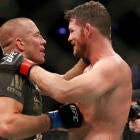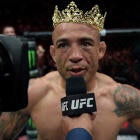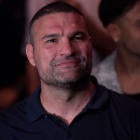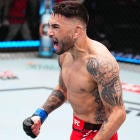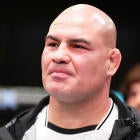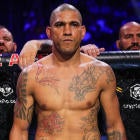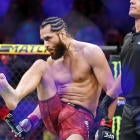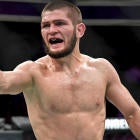UFC 217 was everything mixed martial arts fans could've asked for -- and then some.
Constant drama, a trio of title changes and the dramatic return of one of the sport's greatest fighters left fans and critics debating whether the UFC's second trip to New York's Madison Square Garden was its best show in history.
But considering the dramatic changing of the guard in three divisions, UFC 217 left more questions than answers about the future. Let's take a look at biggest ones facing UFC:
1. Can GSP truly compete against the UFC's best middleweights?
Asking that question might seem silly on the surface considering Georges St-Pierre is the new 185-pound champion, having dramatically defied cage rust, age and a four-year break from the sport to submit Michael Bisping. But at 38, there's a case to be made that Bisping wasn't even the fifth best fighter in his division. After all, following an upset of Luke Rockhold via stunning first-round TKO in 2016, Bisping's reign has consisted of 46-year-old Dan Henderson, a nagging knee injury and a 13-month layoff.
If UFC president Dana White has his way, St-Pierre will return after healing up to face interim champion Robert Whittaker, likely in Australia, where the red-hot "Reaper" is from. But like anyone else in the top five of the middleweight rankings, the 26-year-old Whittaker is no joke and is 7-0 since moving up to 185.
St-Pierre, 36, relied on his grit and Hall-of-Fame technique to outlast Bisping and overcome a bout with fatigue in the second round that slowed him down. But GSP still absorbed punishment to get there -- including sizable cuts and heavy bleeding from his nose and eye -- and admitted after the match he was hurt multiple times. And that was Bisping. How much damage would St-Pierre need to accrue in order to out-grind larger middleweights like Rockhold, Yoel Romero, Ronaldo "Jacare" Souza and Chris Weidman?
The true debate for GSP comes down to muscle and how much time he put in rebuilding his body. Dropping muscle to move back down to 170 is far more dangerous than cutting weight, particularly late in a fighter's career. One has to look no further than how boxer Roy Jones Jr.'s career fell apart at age 34 when he moved up to heavyweight for one fight and attempted to cut nearly 20 pounds of muscle to return back down two divisions.
White told reporters that the Whittaker fight was "a done deal," but also said he hadn't talked to St-Pierre, who skipped the post fight news conference for a trip to the hospital. St-Pierre was asked inside the cage by Joe Rogan whether he would campaign at middleweight and provided a very noncommittal answer.
"Well this is not really my real weight. I did it for the challenge," St-Pierre said. "There was a time in my career I was too busy. The challenges were one after the other and I was too small to go up. I was even small for welterweight. Now, I'm still welterweight size, but I decided to take a shot because I put on muscle mass. There is a point that it's too much but now I'm at the point where it is OK."
The unavoidable fact might be this: St-Pierre can make much more money seeking superfights at welterweight against smaller opponents, where the likes of Conor McGregor, Tyron Woodley and the Diaz brothers (Nick and Nate) currently compete. Under new ownership, UFC also doesn't hold as much leverage to threaten fighters as in the past and St-Pierre has long been someone to stick to his guns. Whichever division he decides to stay is likely where he finishes his career.
2. Is 125 pounds really the best weight for Demetrious Johnson vs. TJ Dillashaw?
Immediately after former champion TJ Dillashaw rallied to knock out Cody Garbrandt to regain the UFC's bantamweight crown in Saturday's co-main event, any talk of an immediate rematch between the hated rivals and former teammates was put on the back burner. Instead, both White and Dillashaw were very matter of fact that his next fight would be a move down 10 pounds to finally give pound-for-pound king and flyweight champion Demetrious Johnson the superfight he has coveted.
The idea for Johnson-Dillashaw isn't a new one and was tossed around ahead of UFC 213 in July after Garbrandt's back injury forced him to pull out of the originally scheduled Dillashaw fight. Both fighters have been incredibly willing to make the fight, but White's reveal that the bout will take at flyweight, where Dillashaw has never competed, doesn't seem to make the most sense for all parties.
Johnson owns the UFC's record for title defenses, but has never been a big enough draw to justify Dillashaw needing to come to him. He also might end up receiving a pronounced advantage should Dillashaw be compromised by the weight. Considering both are elite champions, a catchweight fight where neither title is on the line other than P4P king of the sport might be apropos.
It could make just as much sense for the fight to be at bantamweight, where "Mighty Mouse" campaigned before UFC created a 125-pound division. A victory in that case would even further stamp Johnson's claim that he's the greatest fighter in the sport's history.
To his credit, Dillashaw instantly dismissed concerns late Saturday that dropping 10 pounds from his already ripped frame might leave him weak. "The reason why I look so lean at 135 pounds is the way I work," said Dillashaw, who walks around at 150 pounds. "I put muscle on, I'm not a big 135er."
3. Should a Rose Namajunas-Joanna Jedrzejczyk rematch be automatic?
This one is easy: Yes. While not every UFC champion gets the luxury of an immediate rematch following a close or surprising defeat (Rockhold and Dillashaw included), someone with the resume of Jedrzejczyk is certainly deserving. Entering the fight one win shy of equaling Ronda Rousey's record for UFC title defenses by a female, the talk was increasingly becoming whether "Joanna Champion" was already the best women's fighter in history. Three minutes and three seconds later, Jedrzejczyk shockingly tapped out due to strikes. Her loss on Saturday was quick, stunning and thorough, and certainly a feel-good story for Namajunas. But this one has "run it back" written all over it.
4. Should Tyron Woodley be retroactively pardoned after Stephen Thompson's performance?
This is a weird one, right? Tyron Woodley, the UFC's welterweight champion, endured criticism from none other than White himself for how technical and calculated (i.e. boring) his two-fight stand with Stephen Thompson was over the past 12 months. But Woodley, who fought to a majority draw and majority decision win over Thompson, let his voice be heard after watching "Wonderboy" systematically confuse and break down fellow top contender Jorge Masvidal on Saturday.
🤔 Not that easy huh!? @ufc "You shoulda...." @WonderboyMMA is a tough cookie to figure out!
— Tyron T-Wood Woodley (@TWooodley) November 5, 2017
Woodley has certainly proven he's willing to play it safe in order to secure a victory. His sleepy five-round decision over Demian Maia in July once again drew the ire of White, who claimed the lack of entertainment was the reason Woodley missed out on fighting a returning GSP. But that doesn't take away from how little respect overall that Woodley -- who possesses an elite combination of speed, power, wrestling and smarts -- has continuously received from fans, critics, UFC and even oddsmakers, who installed Woodley as a betting underdog for eight straight fights until Maia.
5. Is there any chance Paulo Costa is as dangerously good as he looks?
Every UFC middleweight is probably asking themselves the same question after Costa, formerly known as Paulo Borrachinha, walked down and destroyed former welterweight champion Johny Hendricks on Saturday. Costa, a native of Brazil, is built like a Greek god and fights at an unyielding pace. Comparisons to a young Vitor Belfort wouldn't be out of the question in this case. Of his three UFC wins, none were as impressive or as important as Hendricks, which now formally announces the 26-year-old as one to watch as he climbs the ladder.












